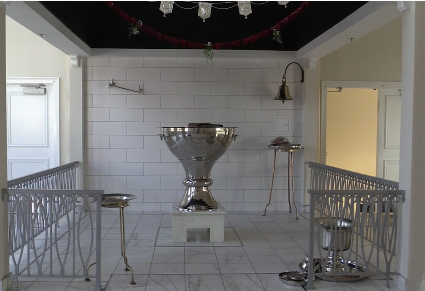RAMAPO, N.Y. — The new home for followers of one of the world’s oldest religion has opened to serve as a meeting place and sanctuary for some 1,000 followers of Zoroastrian faith from across the New York region.
The Dar-e-Mehr Zoroastrian Temple, or DMZT, a gleaming square building with an impressive colonnaded portico opened at the start of Nowruz, the Persian new year — a beacon of optimism and hope in the next generation
Zoroastrianism is believed to be one of the world’s oldest monotheistic religions, dating back some 4,000 years to Persia, modern-day Iran. Before there were Christians and Muslims and Jews, there were Zarathushtis, as its followers are called, after their prophet Zarathustra. Scholars believe the Magi who came to honor the baby Jesus in Bethlehem were Zoroastrian priests from Persia. Today, there are fewer than 200,000 Zarathushtis worldwide, and their numbers are shrinking.
The religion’s watchwords are “good thoughts, good deeds, good words,” and the followers employ fire as a symbol of their belief. The altar holds a huge “kebla” or fire vessel in which wood burns during services. Before entering the prayer room, visitors remove their shoes and cover their heads. Priests cover their faces with cloth to keep the fire pure.
This new temple’s single roof shelters two branches of Zoroastrians: those from Iran, under the Iranian Zoroastrian Association; and those from India and Pakistan, under the Zoroastrian Association of Greater New York.
About 1,400 years ago, when Persia was invaded by Muslims, some Zarathushtis fled to India, where their faith took root. They are called Parsis, while those who stayed in Persia are called Iranian Zoroastrians.
The $4.5 million temple and community center was built on the site of the former temple, which had been a synagogue before it was purchased in 2001. “Dar-e-Mehr,” sometimes seen as “Darbe-Mehr,” translates to “Door of Peace” or “Door of Justice.”
When Zarathushtis pray — to their god, Ahura Mazda — it is often outside, and fire is nearby. Temples are used for special occasions or services of thanksgiving, called “jashan.” The March 26 opening was a jashan, presided by a high priest from India, with 30 priests taking part.
When she lived in Manhattan, Marzie Jafari used to travel to New Rochelle to be with other Zarathushtis. She moved to New City in 1996 and still made the trip to New Rochelle. The DMZT’s 2001 move to Pomona made the drive much easier.
As she walked visitors through the building, Jafari said the new temple is a reason to celebrate, and to find more opportunities to gather.
“Now that we have a magnificent center, I think there will be more events and more visitors on a regular basis,” she said.
Although the Parsi and Iranian cultures and communities may be different, Jafari said, when worshipers come to the Dar-e-Mehr, “it’s the same prayers in the same language, the same concept.”
The fire vessel in the prayer room is based on the 250-year-old prototype found at a historic temple in Mumbai, India.
(Peter D. Kramer reported this story for The (Westchester County, N.Y.) Journal News)





